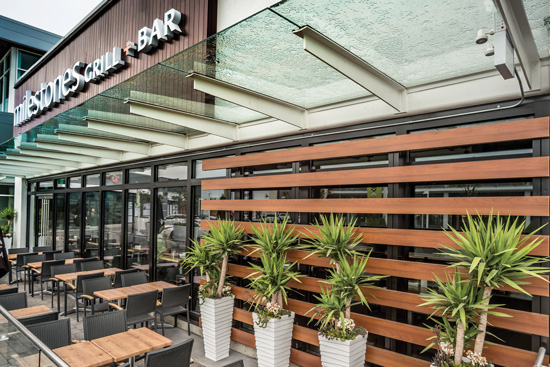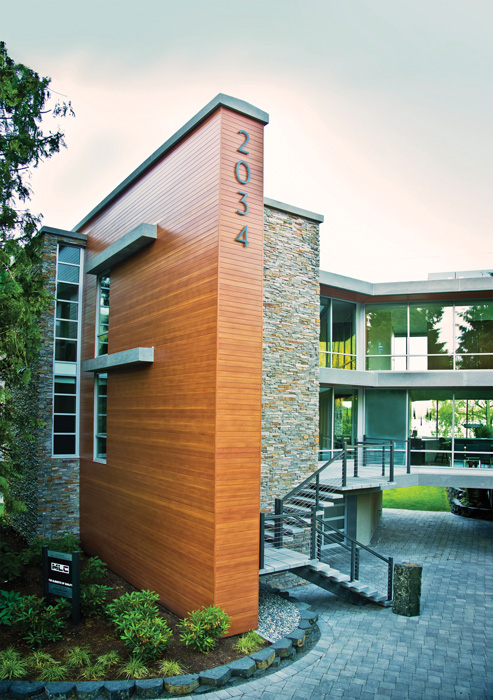Easing Minds and Boosting Facade Performance
PRODUCTIVITY AND WELL-BEING, NATURALLY
An entire city that appears to be clad entirely in wood is a compelling image indeed, and recent architectural applications of real timbers, veneers, and woodgrain patterning suggest that this vision is completely achievable today. The next question to arise might be, “Why would that be the preferred image for a city, a campus, or even a house?”
One of the strongest arguments for the incorporation of natural-looking wood elements in the built environment is their positive effect on productivity and overall well-being, says Longboard’s Dunkley. She points to some landmark studies conducted by leaders in EBD and biophilic design to highlight the benefits, which have been discussed widely at recent industry events. First cited by many practitioners is the seminal 2008 collection edited by Kellert along with Judith H. Heerwagen, a psychologist and noted expert on the evolutionary basis of environmental aesthetics, as well as Yale researcher Martin L. Mador. The book, Biophilic Design: The Theory, Science and Practice of Bringing Buildings to Life, charts a course for applying biophilic design at any scale to “connect people with nature and provide comfortable and productive places for people” to live, work, and study.
Specific evidence shows how architecture connected to nature and with plentiful sunlight, fresh air, and other restorative elements can deliver proven advantages in terms of human health, childhood development, health care, and other key aspects of life. Kellert’s aim is to show how “buildings that echo the environment in which the human species evolved” allow all people to “learn better, work more comfortably, and recuperate more successfully.” These are not merely qualitative improvements; measures of enhanced worker productivity and retention as well as reduced student absenteeism and even sick days are tied to increases in daylight, outdoor views of trees or landscapes, water features, and the use of natural materials.
In this way, the idea of sustainable is expanded beyond a reduction in environmental impact to encompass a raft of general guidelines that make architecture increasingly beneficial to humanity. The applications run the gamut from the potentially expensive to various low-cost, low-impact strategies, many of which stimulate the human brain, strengthening neural networks. “Studies have shown that viewing an attractive complex fractal pattern can trigger the part of the cerebellum that makes a person want to reach out and connect,” according to Lorraine Francis, AIA, LEED AP BD+C, regional director of hospitality interiors at Gensler. She adds that while it seems paradoxical, by helping boost the brain’s production of melatonin during the day, exposure to daylighting actually helps people sleep better at night. Other ecological aspects can elevate mood, reduce mental fatigue, and even minimize stress levels, she explains.
The reasons some techniques succeed in decreasing stress are not fully understood, but evidence points to the kinds of effects Francis describes. Outdoor views of trees, for example, generally reduce work-related stress and increase job satisfaction, according to a 2007 study published by the Scandinavian Journal of Forest Research.6 In another large-scale research effort, a team recorded levels of cortisol, a stress hormone, in adults living in various urban and suburban locations. The findings showed that those living near large green spaces actually had lower cortisol levels, according to a summary in the publication Landscape and Urban Planning.7 To tap into this effect, many architects are incorporating green walls and partitions with planters in their own design studios, such as at the London office of HOK.
Are these effects worth exploring today? Probably so, say many experts in psychology and other social sciences. In a sample of 25,000 full-time workers in North America, high levels of stress were reported by well more than half—about 57 percent—according to a recent study by Carleton University and Western University, both in Ontario, Canada. “Stress levels have gone up and life satisfaction has gone down,’’ summarized Carleton’s Dr. Linda Duxbury, one of the researchers, pointing to smartphone use, childcare, and eldercare as a few reasons that worker well-being is suffering.
Adding natural elements to the designs of buildings can be a cost-effective and ameliorative antidote for at least some portion of these stressors. Moreover, it is easy to argue that the strides taken in green building easily offset any incremental costs of adding natural ingredients and imagery into today’s architecture. According to Herman Miller, “Combine LEED metrics with essential biophilic elements, some argue, and you achieve a lasting sustainability, a built environment that uses less energy even as it energizes the people who use it.”
COST-BENEFIT ANALYSIS OF WOOD-LOOK ALUMINUM
In fact, wood colors and graining can be incorporated into most building typologies without any cost premium if the task is approached creatively and analytically. One of the solutions is the use of today’s mass-customized and photorealistic printing methods to add woodgrain patterns and other nature motifs to various kinds of substrates. Some architects may contend that real stone, leaves, and wood are better than their mere imagery, which in some ways is a defensible position. Others may question the benefits of natural-appearing products actually made with sublimation processes and powder-coat finishes. Yet the analysis by means of LCA as well as a defined return on investment (ROI) suggests otherwise.

Photo courtesy of Longboard – A division of Mayne Coatings Corp.
Woodgrain aluminum tubes in a light cherry finish are used for a privacy screen at a terrace restaurant.
The key is to evaluate the cost-benefit impacts of using low-maintenance metal cladding systems with a woodgrain finish in terms of first costs, long-term maintenance, and payback on human factors. One LCA study of cladding by the University of Tennessee’s Center for Clean Products compared aluminum composite panel envelopes with brick, granite, limestone, and precast concrete. Funded by the Natural Stone Council, the report stated that “aluminum is well suited to exterior building applications due to its inherent resistance to corrosion.” It also noted that a “broad span of lengths and widths are available to meet project specifications.” More to the point, the study notes that “aluminum cladding rarely requires maintenance,” and that panels systems are “easy to repair and replace as needed,” and that the cladding itself may last for up to 50 years, citing an IAI study from 2009, although the United Kingdom-based Metal Cladding and Roofing Manufacturers Association (MCMRA) studies show that coatings may not last as long in terms of maintaining aesthetics.8

Photo courtesy of Longboard – A division of Mayne Coatings Corp.
For a home surrounded by natural beauty, Steven Morris Cross Architect combined wood-patterned aluminum panels with glass spans, stone cladding, and 1,500 square feet of aluminum siding and soffit panels in a light cherry finish.
Low maintenance—along with the benefits of biophilia—was one of the reasons that architectural designer Steven Morris Cross Architects, Langley, British Columbia, elected to specify wood-patterned aluminum panels for Cultus Lake Home, a modern lake house on Lindell Beach, a town in the province surrounded by mountains, forests, and bodies of water. The exterior includes glass spans, stone cladding, and 1,500 square feet of 4-inch V-groove aluminum siding and soffit panels in a light cherry finish wood grain. “The home was designed to be low/no maintenance, with a strong connection to the surrounding elements,” Cross says. “The client and I wanted to use the durable aluminum product from the very beginning,” in part because of their inspiration from a nearby shingled bungalow.
The 30-foot-tall wood-look planes “effortlessly nestle against the nearby trees, while directing the onlooker’s attention to the fresh water lake and surrounding mountains,” says Cross. “The house and siding look great throughout all seasons, and the client doesn’t worry about staining or painting,” he notes, adding that he has since used the product on numerous commercial, institutional, and multifamily residences. “We use it vertically and horizontally on walls, and frequently for soffits,” says Cross. “I’ve even used it as a ceiling in a client’s natatorium.” For this house and the other projects, Cross notes that a natural, psychologically beneficial wood appearance is possible with aluminum products that eliminate the worry about regular maintenance associated with real wood.
In terms of first costs, long-term maintenance, and payback on human factors, Cross—and a growing cohort of leading architects—see wood-patterned aluminum as a valuable step toward a more humanizing, calming, and nature-inspired sustainable architecture.
As Kellert has famously declared, “Human dependence on nature that extends far beyond the simple issues of material and physical sustenance to encompass as well the human craving for aesthetic, intellectual, cognitive, and even spiritual meaning and satisfaction.”
C.C. Sullivan formerly was chief editor of an architectural magazine and his marketing communications agency, C.C. Sullivan, specializes in architecture and construction.
END NOTES
- Berent, Jonathan. “Social Anxiety: The Untold Story.” The Andrew Kukes Foundation. December 2011. Web. February 2016.
- Vidler, Anthony. Warped Space. The MIT Press. September 2000. Web. February 2016.
- Herman Miller Inc. “Nature-Based Design: The New Green.” Web. February 2016.
- Browning, William; Ryan, Catherine; and Clancy, Joseph. “14 Patterns of Biophilic Design.” Terrapin Bright Green, 2014. Web. February 2016.
- Grabow, Stephen and Spreckelmeyer, Kent. The Architecture of Use: Aesthetics and Function in Architectural Design. Routledge, 2015. Web. February 2016.
- University of Tennessee Center for Clean Products. “Life-cycle assessment of cladding products.” December 2009. Web. February 2016.
- Thompson, Catherine Ward, et al. “More green space is linked to less stress in deprived communities: Evidence from salivary cortisol patterns.” Landscape and Urban Planning, Volume 105, Issue 3. April 2012. Web. February 2016.
- Madren, Carrie. “A Tree-lined Path to Good Health.” American Forests, Fall 2011. Web. February 2016.
 |
Longboard – a division of Mayne Coatings Corp. Mayne Coatings Corp. is best known as the manufacturer of Longboard Products. The company focuses on continually exceeding environmental standards and providing premium architectural products for sustainable design. www.longboardproducts.com |








